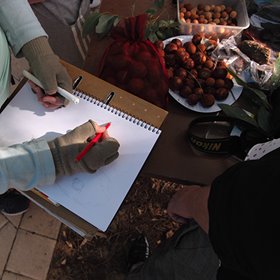 Re-invigorating the residency model:
Re-invigorating the residency model:
ArtsHouse at Cyril Jackson Senior Campus
words by Elizabeth Pedler
I’m standing in the garden beside ArtsHouse at Cyril Jackson Senior Campus (CJSC), and samples of edible and medicinal native plants are being passed around from hand to hand. Sandalwood nuts still in their leathery husks, quandong fruits and seeds, fragrant native lemongrass, balga resin, wattle seeds, and dried eucalyptus sap in chunks like rough gemstones. Mort pulls leaves off a nearby sugar-gum, to show the amassed group of students and teachers how to lick the lerps[i] off the leaves.
The afternoon had begun with Whadjuk Nyoongar elders, Mort and Vivienne Hansen, and Perth Nyoongar artist, Sharyn Egan, speaking to the staff and students in the Jacaranda Theatre at Cyril Jackson Senior Campus. The event in April 2018 was part of Sharyn’s eight-week residency at ArtsHouse — an artist-in-residence (AiR) program located on-campus. I was fortunate enough to attend the event at ArtsHouse, and to learn from the staff, students, and members of the community how their AiR program functions within the school setting.
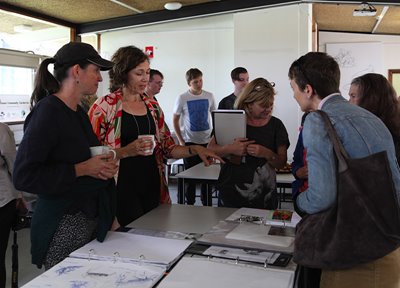
Placing artists within an educational environment, the program generates opportunities for creative exchange between artists and students. ArtsHouse offers an example of an artists-in-schools program that delivers outcomes for artists, the school, and the community.
Mort and Viv are both larger than life, and very direct in their style. Speaking to students in the theatre, Mort and Viv shared their personal and family histories, marred by persecution and loss. They emphasised the need for greater recognition of Indigenous history and knowledge, calling on teachers and schools who have an opportunity to shape the next generation. Sharyn then presented slides of her work. She discussed how her practice tells the story of her family, and her connection to her Nyoongar heritage. Sharyn’s body of work ranges from painting with oils and natural resins from balga trees, to vessels turned from balga root stumps, the Narrogin Dolls project, large-scale weaving works for public art[ii], and her land art piece using collected Banksia — Moorditj Wirrin Kep (2017).
Sharyn’s artwork struck me as an incredibly diverse practice. She has been exploring new materials and pushing their boundaries throughout her career. Although she challenges herself materially, through her work she consistently tells the story of connection — both disrupted and sought — to family, to land, and to lived history.
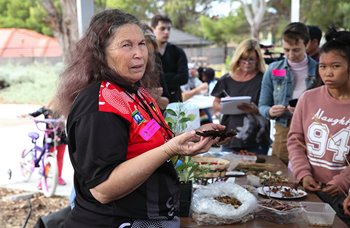
The stories of rupture and loss told in Mort and Viv’s family histories, and through Sharyn’s artworks, were compelling. The audience was quiet and respectful as Mort, Viv, and Sharyn spoke, with both students and staff clearly affected by their stories.
Later, across the campus at the ArtsHouse building and community garden, Mort and Viv led a workshop focused on edible and medicinal Indigenous plants. As Mort and Viv spoke, handing around plants and nuts, Sharyn borrowed a lump of balga resin and demonstrated how to crush and grind it into a powder. She poured the grounds out of the paper bag, the resin transformed from a bloody-black lump into a vibrant orange powder. The ground resin, she stated, can be used as a pigment, mixed with methylated spirits as a varnish, or melted and burned onto a surface with a heat torch.
In addition to the AiR program, ArtsHouse hosts a ceramics workshop and the ArtsHouse Community Garden. The garden is maintained by volunteers who tend a garden of vegetables and native plants surrounding the studio. And as students and staff members picked up seeds and asked questions, Emma Slavin — landscape designer, educator, gardener and an ArtsHouse Community Garden volunteer — rallied students around to plant a selection of native plants around the ArtsHouse. She showed students how to transplant seedlings from their pots into the ground.
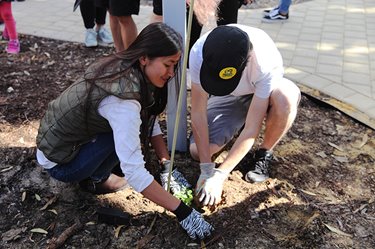
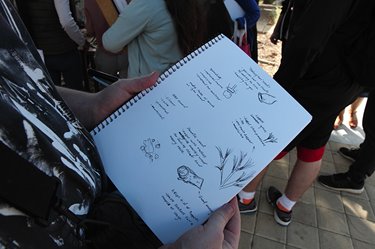
I spoke with Shonie McKibbin, Assistant Project Manager of the ArtsHouse project and another of ArtsHouse’s many volunteers. I learned from Shonie about ArtsHouse, and their take on the Artist-in-residence (AiR) program. The ArtsHouse program began in 2014 with a process of consultation: connecting to the community, the Town of Bassendean, local businesses, and to Artsource — building broad support for a residency[iii]. Today, ArtsHouse offers resident artists accommodation, access to campus facilities, studio space, and a fee for their time and materials. In exchange, artists spend some of their time in the class-room with the Year 11, 12, and VET students. The art teachers Marie Molloy (who is also the ArtsHouse coordinator), Dee George, Loretta Lincoln and Kayleigh Geldenhuys structure the class-time and the curriculum around the availability and skill-sets of the resident artists, maximising the engagement between artists and students.
Across 2018 and 2019, Sharyn is one of three artists conducting residences at ArtsHouse, each for approximately eight weeks. Past ArtsHouse artists-in-residence also remain a strong part of the CJSC community[iv]. Emma Lashmar, the first artist to make use of the renovated accommodation at ArtsHouse, is a volunteer across both the ArtsHouse studio and the community garden — one of the many volunteers connected with program. Showering praise on the talented and committed members of the community that ArtsHouse has attracted as volunteers, Marie recognises that without them, the residency, community garden, and cross-curriculum projects would be difficult if not impossible to run.
The embedded nature of artists-in-schools is not unique to ArtsHouse. Artists have been in schools for as long as art has been taught to students. However, an exchange formalised through an AiR program, is more recent. Guildford Grammar School has been operating an AiR program in their senior school art department since 2007[v] and prior to this, the Short Term Artist in Residence (STAR) program had been developed and funded by the then Department of Culture and the Arts. ArtsEdge (a joint initiative between WA State Government Department of Education and Department of Local Government, Sport and Cultural Industries) also provides support for artists and schools working collaboratively on projects. Between 2009-2016 ArtsEdge funded 44 AiR projects in a variety of educational settings across WA[vi]. However, ArtsHouse is unique in its capacity to host artists on an ongoing basis, and in its community-centric focus.
In some ways, the ArtsHouse residency shares more of a heritage with the exchanges generated by the Artist Placement Group (APG), than traditional AiR programs. APG, founded by John Latham and Barbara Steveni, operated from 1966-1989 in the UK, placing artists inside commercial factories and organisations[vii].
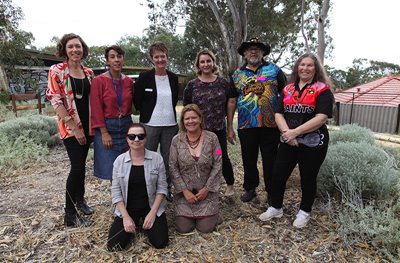
Selected artists were temporarily embedded in the daily life of a business, with a focus on collaborative exchange between artists and their context. The results sometimes took the form of artworks utilising materials from the workshop floor, at other times resulted in actions to improve workflow or morale. ArtsHouse places artists alongside educators, not factory workers. Nonetheless, rather than an AiR that provides an independent space for the artist to self-reflect, ArtsHouse places the artist directly into the school, facilitating engagement with the students and community, and opening the artist’s practice to the students, allowing for reciprocal learning and scrutiny.
In conversation with Marie Molloy however, the inspiration for the ArtsHouse AiR program was closer to home. Marie recalled witnessing the community created around the kiln in her student years at Edith Cowan University:
"One of the things that was interesting, was when I was at ECU, the ceramics and sculpture program built a garden in the centre of the space. People used the kilns for making bread and pizza, creating a community of people working together and growing food together, and conversations would come out around that; it was a really collaborative feeling."
Though Marie is quick to point out the hazards of firing food and pottery in the same oven, it was this sense of community that she wanted to bring to CJSC.
"The Arts Department is such a vibrant group of people. I wanted to create a space that could provide for collaborative experiences across the campus and across curricula; being able to look at education in that way, to create an environment where that could happen."
I spoke with two of the students about how Sharyn had been working with them in the classroom on their print designs and giving feedback on their portfolios. They found Sharyn to be very supportive, and seeing her practice opened a window into the realm of the professional artist as she shared her processes and work-life at the ArtsHouse studio on-site.
Artists sharing their studio processes with students is something that Marie Molloy is particularly passionate about. She describes how engaging students in experiential learning programs and seeing professional artists at work has motivated her classes: "students who were disengaged are now incredibly engaged, even outside school hours, attending ceramics workshops and workplace learning." Many often ask her if she was coming in on Saturdays or holidays, so they can spend more time on their artwork.
The event with Mort, Viv and Sharyn was a testament to a high level of engagement. Even though all the students had officially finished their classes at lunchtime, more than thirty remained to attend the presentation, the native plants workshop, and to participate in the planting. Throughout the event I noticed how engaged the students were; listening, asking questions, drawing, and writing notes.
Through the AiR and the complementary community garden and ceramics workshop programs, ArtsHouse brings General, ATAR and VET students and the CJSC community into regular contact with the working lives of professional artists and arts organisations, and embeds artists into a community of students, teachers, local artists, volunteers, and wider community supporters. Solid connections have been established and layered outcomes have been generated for all those involved. In WA, ArtsHouse is a noteworthy AiR program, facilitating an ongoing exchange between artists and a school community. It perhaps also offers an insight, into how a school that is focused on building relationships and community, rather than on test scores[viii] can create something that re-energises learning, and delivers mutual benefits to the school and the community.
The ArtsHouse AiR program is funded by a Copyright Agency of Australia Cultural Fund grant to Artsource and Cyril Jackson Senior Campus.
Elizabeth Pedler is an artist, curator, and writer based in Perth. She has undertaken residences in Launceston, Greenough, Casula, Melbourne, and Perth, including an artist-in-school residency at Maylands Peninsula Primary School in 2016. In 2017 Elizabeth completed a PhD at Curtin University, writing about exchange and participatory art practices.
Further reading
More information about AiRs and artists-in-schools opportunities can be found at Artsource Residencies and ArtsEdge.
For a list of funding accessible for artists-in-schools, click here >
Images (top to bottom)
-
Student visual diaries, ArtsHouse AiR program, 2018. Photographer: Perdita Phillips
-
Artist Sharyn Egan, ArtsHouse AiR program, 2018. Photographer: Perdita Phillips
-
Looking at folios inside ArtsHouse, ArtsHouse AiR program, 2018. Photographer: Perdita Phillips
-
Vivienne Hansen’s workshop on Nyoongar culture and use of plants, ArtsHouse AiR program, 2018. Photographer: Perdita Phillips
-
Planting seedlings in the garden, ArtsHouse AiR program, 2018. Photographer: Perdita Phillips
-
Student visual diaries, ArtsHouse AiR program, 2018. Photographer: Perdita Phillips
-
Artist, staff, students and volunteers in the ArtsHouse Community Garden, ArtsHouse AiR program, 2018. Photographer: Perdita Phillips
Details: Back Row: ArtsHouse Assistant Project Manager Shonie McKibbin, Art Teacher Dee George, Principal Dr Karen Read, ArtsHouse Co-ordinator Marie Molloy, Mort and Vivienne Hansen. Front Row: ArtsHouse Garden Volunteer Nonie Jekabsons and Artist in Residence Sharyn Egan
[i] Sugary white excretions made by psyllid larvae for protection.
[ii] Such as the hand-woven dillybag made for Ninny Yok of The Giants for the Perth Festival in 2015.
[iii] During the community consultation period, an ‘ideas festival’ was staged to share the plans, and open the building, formerly a caretaker’s cottage, to the school and stakeholders.
[iv] Since 2014, ArtsHouse artists-in-residence or visiting artists have included Peggy McKenna, Emma Lashmar, Andy Quilty, Claire Bushby, Michael Grau, Lucy Brommel, and dance company Co3.
[v] Guildford Grammar AiR alumni include Thurle Wright, Dragica Milunovic, Beverley Iles, and author Shane McCarthy.
[vi] ArtsEdge funding for AiR projects was discontinued in 2016. A listing of all the projects funded by ArtsEdge can be found on the archives page: http://www.artsedge.dca.wa.gov.au/artists-in-residence/Pages/Project-Archive.aspx
[vii] APG Member Ian Breakwell visited PICA in the late 1980s/early 1990s during Noel Sheridan’s directorship. More information about APG can be found on the Tate website: http://www2.tate.org.uk/artistplacementgroup/
[viii] The emphasis on ATAR and NAPLAN results has been criticised by Ministers from State Governments, as well as scientist Dr Alan Finkel, as highlighted in recent articles. (Robinson, Natasha, ‘NAPLAN testing faces scrutiny as education ministers push for changes’ 15 February 2018, accessed at 19 May 2018, http://www.abc.net.au/news/2018-02-15/naplan-testing-faces-scrutiny-and-push-for-changes/9446842; ‘ATAR is starting to cost us marks’ 25 April 2018, accessed at 19 May 2018, http://www.smh.com.au/national/nsw/atar-is-starting-to-cost-us-marks-20180425-p4zbli.html)